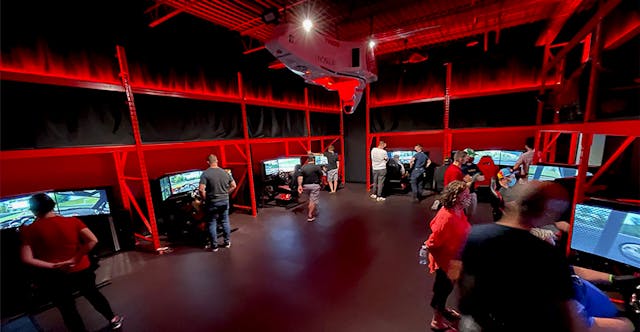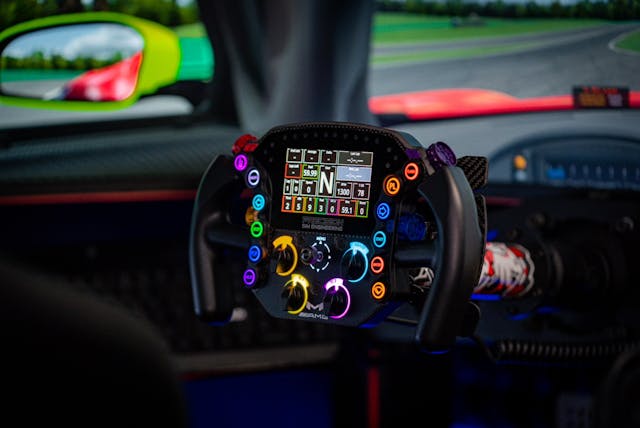Sim racing is fast evolving from pastime to training aid to full-time career

I’ve had a long-term, love-hate relationship with virtual driving.
About a decade ago, I persuaded Porsche that it would be a good idea if I took a 997 around the Nordschliefe. After Stuttgart agreed, I prepared for those laps by driving the circuit virtually in Forza on Xbox. The quality of Forza’s simulation wasn’t great in those days, and it certainly has improved since then, but at least the program gave me a feel for the rhythm of that incredibly challenging circuit. Yes, I was able to post a decent bridge-to-gantry time and keep that yellow Carrera S off the walls.
My experience with virtual driving has run the gamut from the Pole Position in my small-town arcade to multimillion-dollar, driver-in-the-loop simulators and everything in between. Until recently, the pinnacle of my virtual driving experience was piloting Multimatic’s driver-in-the-loop simulator at its technical center in Markham, Ontario. It’s the same machine the Canadian firm used to engineer the Le Mans-winning Ford GT and its road-going counterpart.

The reason I love virtual driving is simply that I always have something to learn. If you’re not learning, you’re stagnating, as they say. Whether I’m driving on a real track with real consequences or burning virtual rubber, it doesn’t matter. I love sim driving because it’s an efficient use of my time and there are zero consequences for any harebrained mistakes I’m bound to make. Plus, the engineering that goes into simulator hardware and software fascinates me.
On the other hand, I’ve long associated sim driving with wasted time, but not in the way you might think. When I had my home rig, I’d fire it up every few weeks and a Windows update would cost me anything from minutes to hours. If I were lucky, iRacing wouldn’t need a patch that day. In the end, I may have gotten in some quality laps, but more often I didn’t, and left frustrated.
In the end, it became clear that I wasn’t driving the rig, so it had to go. Without a dedicated home setup, I found myself jumping on friends’ sims from time to time, but then I discovered sim studios like Ajax, Ontario’s HIP Motorsports.
For a casual sim driver like me, HIP is the perfect place, allowing me to schedule time on a high-quality simulator without the hassle of maintaining it or making space for it in my house. HIP’s founders, Jim Anderson and John Venditti, built out a commercial warehouse into a sim racer’s dream. With eight simulators in the main studio, plus several private simulators, event space, and broadcast capabilities, it’s one of the most advanced studios I’ve experienced.

Early in 2020, Anderson and Venditti were doing some racing at Road Atlanta, and on that road trip they tossed around the idea of a commercial simulator studio. When the COVID-19 lockdowns hit, they found themselves with enough time to put a plan together. After a significant amount of work, HIP was born in the Toronto suburbs.
For much of 2020, I remember my Twitter feed filled with one enthusiast after the next announcing they’d bought a racing simulator. With more people with more spare hours, it was only inevitable that those with the inclination for driving would find their way to sim racing. Someone like me, who’d sold his simulator years before, clearly had the worst sense of timing.
The reality is that the 2020 calendar year caused exponential increase in the demand for simulators, resulting in product shortages and shipping delays, which in turn pushed HIP’s grand opening to May 2021. Now that the studio is open, the simulators are busy with drivers and HIP is hosting events, as local regulations allow. For those customers looking to take home the sim racing experience, the studio also has an in-house boutique for drivers looking to build or improve their personal setups.

Now that HIP is open for business, it’s time for Anderson and Venditti to execute their business plan. Anderson says: “We didn’t build this place to be an arcade for kids’ birthday parties, but we do have these kids with aspirations in motorsports. When a young kid comes in here and wants to race, not just because they want to play a game, we’re all about that.
“For example, John [Venditti] has worked closely with Keaton Pipe, an 11-year-old karter. He has been karting for about three years and last year started to have some success. We met him through the sim racing side of things and we’ve been supporting him.
“John’s been training Keaton on racecraft in a car, not a kart. We clearly differentiate that because what you do in a car, you don’t necessarily do in a kart. Keaton has aspirations to race cars and he knows where he wants to go and his family wants to support that. We worked with him all season in karting and he’s been tearing it up.”
Compared to karting or club racing, sim racing is an entirely different beast. Young drivers have direct access to the business side of sim racing from the moment they begin driving, and there is no shortage of opportunities.
“In car racing and sim racing,” Anderson says, “There’s the actual driving skills that are transferable, but the other thing you have to be as a pro racer is a self-marketing machine. Sim racing gives you that avenue to work your way up and work on your presentation skills.”
The speed with which the sim racing business has developed allows young drivers to quickly learn valuable marketing skills for the virtual world that also transfer to the car racing world. Learning how to speak with business people, learning how to present, and even learning how to pitch sponsorship deals are all opportunities coming faster and easier for young sim drivers than they are for young karting drivers. It’s like the business side of sim racing is baked right in along with learning how to be a decent driver.
Since its grand opening, HIP has developed a community of dedicated drivers from around the Toronto area, from up-and-comers like Pipe to one of Canada’s top professional sports car racers, Daniel Morad. A charismatic Canadian, Morad’s enthusiasm for all things racing is infectious. When you meet him, he flashes a smile as bright as the two-tone Rolex Daytona he won at the Rolex 24 Hours of Daytona in 2017. Given his experience as a handy simulator driver, HIP’s benefited from his pointers along the way.

Morad competes in IMSA’s WeatherTech SportsCar Championship in the GTD category, which is the sanctioning body’s terminology for GT3-homologated sports car-based racers. When he’s not racing his Mercedes-AMG GT3, he’s always found behind the wheel of his simulator. Much like my old-school approach, Morad uses his rig to prepare for upcoming race weekends—and more.
“IMSA racing and sim racing aren’t one-to-one, but there’s definitely a lot of similarities in terms of your mental preparation and consistency with hitting your marks. Those aspects of sim racing definitely help contribute to a proper weekend. In terms of how you drive the car, they’re a little bit different, but on a given weekend, you’re always encountering a different balance in the car, and how you overcome deficiencies in the setup is really up to you and your adaptation. The sim is a different way to drive and you’re also constantly adapting, so it’s a good way to mentally prepare and get you dialed in for a race weekend.”

The majority of pro drivers use out-sourced simulators to some extent, but Morad’s taken his sim driving to the next level. He’s built himself a high-level rig and, like most good sim racers, he can’t remember the cost—though he estimates it around twenty grand.
When he’s not practicing for a race, you can find Morad live-streaming on his Twitch channel. In addition to the simulator, he’s fitted it with five cameras, a microphone, and a mixer. The add-ons piled a few more thousand dollars to his build budget, but they allows him to engage with his 14,000 followers on Twitch. When he’s logged off Twitch, he’s coaching drivers on their simulators.
Morad’s one of very few drivers earning a living as a professional sports car racer as well as a sim racer, but recently a path has emerged where the best sim racers in the world can get paid for driving in the virtual world alone. Forget driving real race cars.

“I’ve spoken to some of the top sim racers about transitioning to real racing,” Morad says, “And most of them said they wouldn’t because they’re making a living as a full-time sim racer and they would actually lose money by transitioning into real racing because they wouldn’t earn a salary straight away, so it’s a tough call.”
In fact, Morad himself is a factory Mercedes-AMG simulator driver. He’s contracted to Mercedes-AMG as a driver in the virtual world (driving one in the IMSA WeatherTech SportsCar Championship may have helped that relationship). Regardless, it’s clear that things are changing for drivers of both realms.
Simulators have done something unexpected for racing enthusiasts. As a direct result of the more modest costs of virtual racing, sims have democratized the sport of motor racing by attracting thousands more drivers than even amateur racing.
While there is an obvious and costly path for sim drivers to transition to real racing, that may now be an outdated perspective. Sim drivers may lack the motivation to make the jump to real racing because, save for Formula 1, IndyCar, and NASCAR, the best sim racers are cashing fatter checks than many of the world’s top professional drivers.
If this trend continues, and it looks like it will, studios like HIP will not only be an entry point to sim racing, but also a place where young drivers can develop their professional careers.

